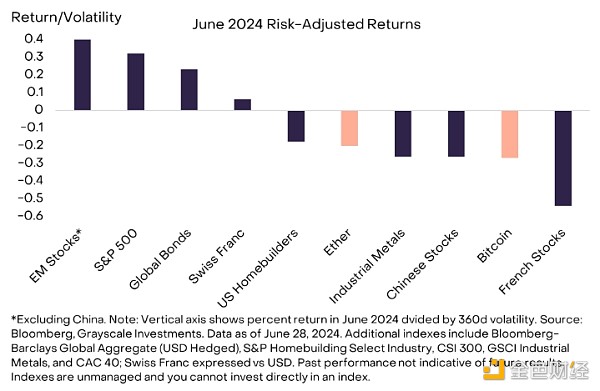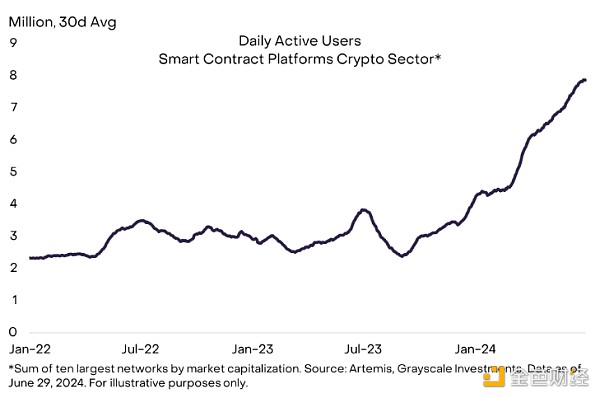Source: Grayscale; Compiled by: Baishui, Golden Finance
In June, continued and expected selling pressure from a variety of sources had a broader impact on Bitcoin and the cryptocurrency market. However, in Grayscale Research's view, the fundamentals of the asset class have hardly changed.
There appears to be more progress in the listing of spot Ethereum exchange-traded products (ETPs). While the timing remains uncertain, for the purposes of market analysis, Grayscale Research assumes that these products will begin trading in the third quarter of 2024.
If there is no major shift in the macroeconomic outlook, Grayscale Research expects cryptocurrency valuations to recover in the coming months.
In June 2024, the cryptocurrency market experienced a pullback due to a general decline in investor risk appetite triggered by some Bitcoin selling pressure, but Grayscale Research remains optimistic about the asset class.
Traditional asset returns were mixed in June as markets priced in a variety of new risks (Figure 1). Several segments underperformed due to these risks, including U.S. homebuilders (there are signs that the housing market has cooled), Chinese stocks and certain industrial metals (China’s economy is weakening again), and French stocks (there may be a change in government). In contrast, risk-adjusted returns for global bonds, emerging market stocks outside of China, and the S&P 500 were relatively solid, as was the Swiss franc—typically a barometer of rising international tail risks. Bitcoin and R, both down about 10%[1], were among the segments that underperformed on a risk-adjusted basis.
Figure 1: Traditional assets were mixed in June, but cryptocurrency valuations retreated

Grayscale Research believes that actual and expected selling pressure from multiple sources caused Bitcoin to fall this month. Bitcoin’s weakness, in turn, appears to have spread to other cryptocurrencies. Major new sources of selling pressure include:
Mt Gox Estate:The trustee of the Mt Gox bankruptcy estate announced on June 24 that repayments of Bitcoin and Bitcoin Cash will begin “from early July 2024.” [2] At the time of writing, the estate holds $8.9 billion worth of Bitcoin. [3] It is uncertain whether creditors will convert proceeds into fiat currency, and within what timeframe.
German Government:German government agencies have begun liquidating Bitcoin confiscated in 2013. [4] According to data provider Arkham Intelligence, wallets associated with the German government sent nearly 4,000 Bitcoin (worth approximately $220 million) to the exchange in June. [5]
U.S. Government:On June 26, the U.S. government sent 3,940 BTC ($240 million) seized from the wallet of a convicted drug dealer to Coinbase Prime Deposit. The U.S. government’s last confirmed sale was in March 2023, when it sold 9,861 BTC for $216 million.
U.S. Spot Bitcoin ETPs:These products saw net outflows of $581 million in the second half of June, compared to net inflows in May and early June. [6]
In addition to these new sources of selling pressure, Bitcoin miners continue to reduce their holdings: According to data from Glassnode, miners have sold approximately 1,560 BTC (about $100 million) in the past 30 days.[7] On the other hand, public company Microstrategy reportedly purchased nearly 12,000 BTC (worth $786 million) in mid-June, likely supporting the price of Bitcoin.[8]
While these short-term flows may temporarily weigh on the price of Bitcoin, we do not see any major changes in the asset’s fundamentals. For example, despite a modest strengthening of the U.S. dollar, the market has priced in further interest rate cuts from the Federal Reserve this year and next as consumer price inflation eases further. [9] In addition, certain adoption metrics for smart contract platforms show continued growth. For example, as shown in Figure 2, daily active users for the 10 largest components (by market capitalization) in our smart contract platform cryptocurrency sector have continued to increase in recent months.
Figure 2: Daily Active User Growth of Major Smart Contract Platforms

In addition, the listing of spot Ethereum ETPs in the U.S. market appears to have made further progress. In late May, the U.S. Securities and Exchange Commission (SEC) approved Form 19b-4 applications from multiple issuers, allowing these products to be listed on U.S. exchanges. On June 13, SEC Chairman Gensler said regulators could approve the remaining applications “sometime this summer.” While the timing remains uncertain, for the purposes of our market analysis, Grayscale Research assumes that these products will begin trading in the third quarter of 2024. As with the spot Bitcoin ETP that launched in January 2024, the Grayscale Research team expects the new Ethereum products to generate meaningful net inflows (albeit less than the Bitcoin ETP), potentially supporting the valuation of Ethereum and tokens within its ecosystem (for more details, see our report “The Current State of Ethereum”). While both Bitcoin and Ethereum fell last month, they both outperformed the broader crypto market as measured by the FTSE Grayscale Crypto Sector Index Series (Exhibit 3). Our Crypto Sector Market Index (CSMI), which measures the performance of the entire digital asset market, fell 19% in June. The worst performing market segment this month was the Consumer and Cultural crypto sector, due to weakness in memecoins (tokens used primarily for entertainment value and associated with internet culture). The Currency crypto sector, which includes Bitcoin, and the Financial crypto sector performed relatively well. Figure 3: Broad decline in the cryptocurrency space While most token prices fell in June, one notable exception was Toncoin (TON), the third-largest asset by market cap in our smart contract platform cryptocurrency space. [12] The TON blockchain is integrated into Telegram’s secure messaging app, with the potential to leverage the distribution of Telegram’s 900 million monthly active users, making it an attractive platform for application developers. Due in part to the growing popularity of its Open League token incentive program and Telegram Games,[13] the network has grown significantly from an average of 27,000 daily active users in January to over 400,000 daily active users in June.[14] Additionally, Tether’s USDT stablecoin launched on the TON network in April 2024 and has seen rapid adoption. In March, the Financial Times reported that Telegram was considering an IPO,[15] which, in our view, could have an impact on the value of public blockchain tokens integrated with applications.
Despite the crypto market setback in June, Grayscale Research remains optimistic about the valuation outlook for the remainder of the year. We believe the macro backdrop remains broadly supportive of the crypto asset class – economic growth, potential Fed rate cuts, and buoyant equity markets.
While a U.S. recession could weigh on crypto markets, a period of slower but positive growth still appears to be the main outlook for the economy. Additionally, the approval of Ethereum ETPs has the potential to expose more investors to the concepts of smart contracts and decentralized applications — allowing public blockchains to potentially transform digital commerce.
References
[1] As of June 28.
[2] Source: Mt Gox Estate.
[3] Source: Arkham Intelligence. Data as of June 28, 2024.
[4] Source: Bitcoin Magazine.
[5] Source: Arkham Intelligence. Data as of June 28, 2024. USD values based on a Bitcoin price of $60,000.
[6] Source: Bloomberg, Grayscale Investments. Data as of June 28, 2024.
[7] Source: Glassnode. Data as of July 1, 2024. USD value calculated by taking the price of Bitcoin on the day it was transferred.
[8] Source: CoinDesk.
[9] Source: Bloomberg, Grayscale Investments. Fed rate cut pricing based on SOFR futures contracts for December 24 and 25. As of June 28, 2024.
[10] Source: Bloomberg.
[11] Source: CryptoSlate.
[12] The Grayscale Research Top 20 represents a diverse group of assets in the cryptocurrency space that we believe have high potential to perform well in the coming quarter due to factors such as (i) immediate catalysts or trending themes, (ii) favorable protocol-specific adoption trends, and (iii) low or moderate token supply inflation. Several of the assets in our Top 20 list have high price volatility and should be considered high risk. This content does not constitute advice and does not take into account an investor’s specific investment objectives, financial situation, or needs.
[13] Source: Decrypt.
[14] Source: Artemis. Data as of June 28, 2024.
[15] Source: Financial Times.
 JinseFinance
JinseFinance
 JinseFinance
JinseFinance JinseFinance
JinseFinance Huang Bo
Huang Bo JinseFinance
JinseFinance Xu Lin
Xu Lin JinseFinance
JinseFinance JinseFinance
JinseFinance JinseFinance
JinseFinance Espresso
Espresso Beincrypto
Beincrypto